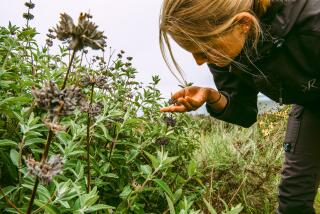How you can help rescue wolves, toucans and other wildlife -- and also see the world
Animals melt our hearts, especially when they’re in distress, but after a tear or two, then what? Taking action that allows us to shake off that helpless feeling and turn our angst into action can be both life-changing and life-affirming. Here are seven volunteer opportunities that not only allow you to help animals but also introduce you to other cultures and places. Understanding, as always, is the essence of the best travels. All prices are per person unless specified.
Performing Animal Welfare Society, San Andreas, Calif.
Mission: PAWS helps investigate and document incidents of abuse of exotic and performing animals and has built a refuge where animals are well cared for and can live without fear.
How you can help: “Seeing the Elephant” education weekend getaways give volunteers a chance to help in the sanctuary in San Andreas, which is not usually open to the public. Saturday is spent helping elephants; Sunday focuses on tigers, lions, leopards and bears. Volunteers prepare animal treats, observe therapies (checking feet, drawing blood, etc.) and maybe give an elephant a bath — if the elephant wants a bath. Because these animals have been abused, PAWS doesn’t force them to do anything.
Costs: $800; $1,300 for two people sharing a room. Two-day program includes two nights in a B&B, breakfasts and vegetarian lunches. One-day program with elephants includes vegetarian picnic lunch: $250.
Info: www.pawsweb.org
Colorado Wolf & Wildlife Center, Divide, Colo.
Mission: The CWWC, which has been certified by the Assn. of Zoos and Aquariums, creates natural habitats for canids that cannot be released back into the wild. It also provides homes for Mexican gray wolves and swift foxes as part of the AZA Species Survival Plan Program.
How you can help: Volunteers work on landscaping, raking, mowing, weed-whacking, gardening, repairing fences, painting, trail-building and so on. With training, volunteers can lead tours and become more involved with the wolves.
Costs: None, but volunteers provide their own food and lodging.
Info: www.wolfeducation.org
ProFaunaBaja’s Sea Turtle Camp Adventure (Todos Santos Eco Adventures), Todos Santos, Mexico
Mission: ProFaunaBaja works with the University of Baja California Sur, the Oceanic Society, Pacsafe Turtle Fund and biologists to conduct research on as well as protect endangered olive ridley marine turtles.
How you can help: At Sea Turtle Camp volunteers walk along the beach during a full moon to search for nesting female olive ridley sea turtles, assist in relocating their eggs to a protected “nursery,” look for new nests and perhaps help hatchlings find their way to the sea. On research trips with biologists from the University of Baja California Sur and Todos Santos Eco Adventures, volunteers help capture, tag, weigh, measure and release sea turtles in foraging areas throughout the year.
Costs: $125 a night at Sea Turtle Camp with tent, cot, dinner and breakfast. (Nesting takes place August-November; best around the full moon). $250 a night for year-round research/tagging trips. Includes meals and dome tents on the beach at Espíritu Santo Island.
Info: www.profaunabaja.org; tosea.net/SeaTurtles.aspx?M=54
Toucan Rescue Ranch, Costa Rica
Mission: Toucan Rescue Ranch creates captive breeding programs for Costa Rica’s six species of toucans; cares for rescued birds, sloths and other animals; and rehabilitates animals for release back into the wild whenever possible.
How you can help: Volunteers chop fruits and vegetables, feed birds, clean cages, make bird toys, do yard work and enter information into computers. Optional activities include feeding sloths, cleaning larger bird enclosures and leading tours.
Costs: $50 a week, not including accommodations, but they can help assist with housing (from $25 a day to $450 a month, including meals). Minimum stay: one month, working five days a week (8 a.m.-1 p.m.). See also Wild Planet Adventures tours, $3,298-$4,998, inclusive.
Info: toucanrescueranch.org. The Toucan Rescue Ranch is included in nine-, 10 1/2- and 14-day tours by Wild Planet Adventures, www.lat.ms/1NiVgjc
ARCAS Rescue Center, Guatemala
Mission: This nonprofit Guatemalan organization takes care of and rehabilitates animals saved from the illegal pet trade. Two veterinarians and four government staff members care for more than 650 animals of 40 species annually, including jaguars, margays, coatimundis, kinkajous, peccaries, scarlet macaws, parrots and spider and howler monkeys.
How you can help: Volunteers help prepare and distribute food, clean and fix cages, work on general maintenance, paint signs, make enrichment toys and look for illness or changes in animal behavior.
Costs: $225 for the first week and $175 for each additional week. Includes meals and accommodations in a shared house
Info: www.arcasguatemala.com/volunteering
Vinaka Fiji Marine Conservation Program, Yasawa Islands, Fiji
Mission: The program helps create Marine Protected Areas intended to develop long-term gains for local communities with food security. Funds raised also help locals.
How you can help: Volunteers, who are asked to bring old toothbrushes to clean the shells of baby clams in the nursery, help reintroduce clams (including giant clams), which are important water filters. Volunteers who snorkel help with observing, identifying, studying behavior and analyzing habitat of manta rays. Divers and snorkelers monitor reef health through observing, recording data and taking photos. They also help map reefs, track species and remove the extremely harmful crown-of-thorns sea star.
Costs: About $1,110 for one week in a dorm room; $1,200 for standard shared twin bure (wood and straw hut); includes meals and training. Price drops for longer stays.
Info: www.lat.ms/1UTnp1s
Free the Bears (World Expeditions), Cambodia and Vietnam
Mission: Free the Bears works to save, rehabilitate and return the animals to a safe sanctuary that feels as wild as possible. It conducts research on bear habitat and works with communities to remove snares. It runs education programs in schools and tries to stop the practice of milking bears for their bile.
How you can help: On the one-day Bear Care Tour, volunteers make treats and enrichment toys as well as hide food in bear enclosures to challenge the animals. On two- and three-day visits through World Expeditions, volunteers build climbing towers and hammocks for the 130 bears in the Cambodian sanctuary within Phnom Tamao Wildlife Rescue Centre. They also work in a garden designed to improve bears’ diet and health. In Vietnam they work on landscaping, terracing and cleaning forest areas as well as weaving grass baskets, a favorite bear toy.
Costs: One-day Bear Care Tours are $70 for one person, but less per person for groups. Two- and three-day visits to Free the Bears sanctuaries are included in several 11- to 15-day World Expeditions tours. From $2,979, including $732 donation.
Info: www.freethebears.org; www.lat.ms/1hD3o18; www.lat.ms/1hWXw2K
ALSO:
As Africa’s animals are killed off, protectors turn anger into action
At a wildlife center in Indonesia, macaques are readied for a return home
Like orangutans? You can volunteer at a ‘forest school’ for them in Indonesia
More to Read
Sign up for The Wild
We’ll help you find the best places to hike, bike and run, as well as the perfect silent spots for meditation and yoga.
You may occasionally receive promotional content from the Los Angeles Times.






